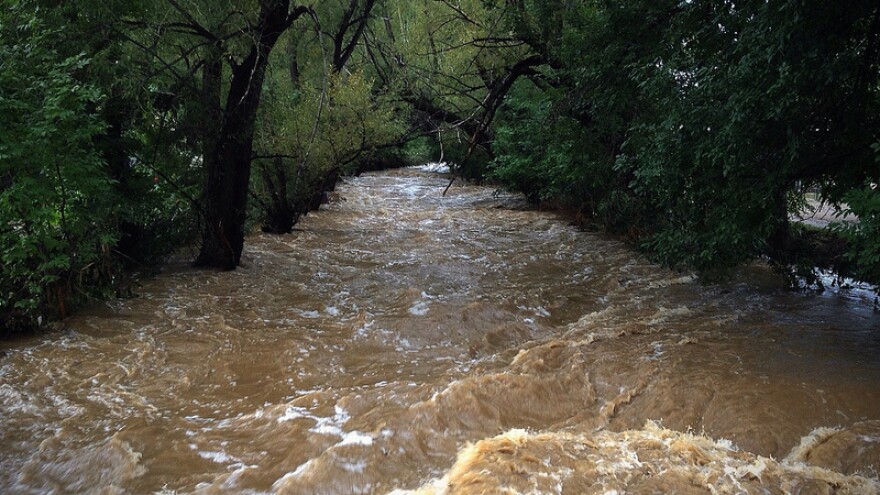In the wake of the historic Front Range Floods, many climate experts and researchers admit that while they’ve known of the potential for dangerous flooding in the Boulder area for some time now, hardly anybody could’ve predicted such a large-scale disaster.
We decided to look into what the floods might tell us about the future of massive storms, and whether the events of last week might change our definitions of "rare" weather events.
Strange, heavy patches of low-lying clouds and thick fog showed up in Colorado a couple weekends ago, along with cooler temperatures, a welcome change from a heat wave that felt much longer than the week it lasted.
I noticed the clouds hanging over the mountain passes on I-70, driving back from Denver Monday morning.

Four days later, those clouds let loose historic amounts of rainfall over the Front Range, devastating the area with the worst flooding the state’s ever seen. Records were broken, and the storm rekindled rough memories of the 1976 Big Thompson Flood.
“What you were seeing were signs that conditions were ripe for rainfall and heavy rainfall,” says Andrew Freedman, a writer for Climate Central. One of his meteorologist friends told him Boulder felt like Houston in the days before the storm – muggy, almost tropical – definitely unusual for Colorado in September.
But according to Freedman, scientists have actually been noticing more of these oddly-timed, extreme rain events across the country, partly because our atmosphere is getting warmer and can hold more water than it used to.
Bob Henson, a meteorologist at the University Corporation for Atmospheric Research, says the moisture buildup itself wasn’t that strange, it was mostly just the timing.
“It’s a little bit like a large-scale version of a sea breeze,” he explains, “where during the middle hours of the day, the land near the ocean coast heats up and creates a pressure pattern that tends to pull in moist air from the ocean.”
“It’s just that usually doesn’t happen this intensely in September,” he says. If you’ve been following the press on the floods, “usually” might sound like an understatement.
Henson says the hype over the “1,000 Year Flood” is somewhat misleading.
“It’s like getting a straight flush in poker,” he says. “Your very next hand could be a straight flush; there’s nothing about having gotten a straight flush one time that prevents you from getting it the next time.”
The thousand-year-flood thing simply means these massive storms have a .1 percent chance of happening in any given year. It definitely doesn’t mean we’re in the clear for another thousand years. And to make it more complicated, Henson says those probability calculations have their own problems. Mainly, they assume that the climate isn’t changing, that it’s stationary.
“There’s this saying going around the climate community that ‘stationarity is dead,’” he says.
“The climate isn’t stationary, the climate is evolving and changing, so you can’t simply extend what’s happened for the last 50 or 100 years forward and assume those calculations aren’t going to change.”
Hensons says scientists generally agree that climate change is likely to make these kind of heavy rains more frequent, and more intense. And that means perceptions of what a rare storm is will change too.
For Doctor Eve Gruntfest, the story of US-34 is proof of that. She says controversy surrounded the rebuilding of that highway after it was destroyed in the ’76 flood.
“The Feds weren’t going to spend money to rebuild the road unless it was above the ‘100-year flood level,’” she says. “People thought that this road was actually built to withstand the 500-year flood, and it is washed away again.”
Gruntfest has studiedthat flood for most of her career. She’s responsible for those green signs you see in Colorado, telling you to “climb to safety” in a flash flood. She cites one scientist who at the time said it was “unreasonable” to use that flood’s destruction to plan for rebuilding roads, or telling people how far away from riverbanks they had to live.
“He said the rain would never last as long, or be as intense ever again,” she says.
But of course, it did, and it was.
“Those of us that study rainfall and floods knew that something like that could happen again, or that it could even be worse,” says Russ Schumacher at Colorado State University. “But it raises the challenges of sort of how rare or extreme an event do you plan for?”
He says flood risk regulations are often based on perceived or calculated probabilities (they don’t call them hundred year flood plains for nothing.) But he cautions that our understanding of massive storms may have to evolve.
“We know that the climate is changing,” he says. “We don’t exactly maybe know how and in what ways, but assuming that it’s not changing may not be the best assumption either.”
“I think we need to really shake up what we’re doing,” says Gruntfest. “Normal is not normal anymore.”
While she feels there's still work to do in how we prepare for, recover from and even conceptualize floods, she’s quick to note that much fewer people died this time around than in 1976.
“I mean no one’s ever seen, or really even anticipated, this kind of flood for the whole region,” she says. “Something must have really gone right.”



